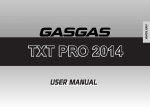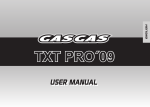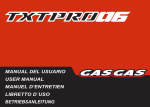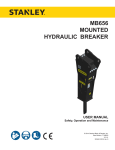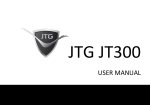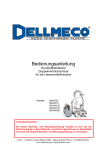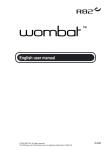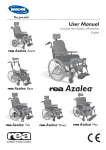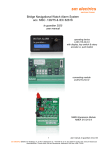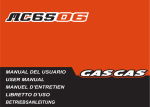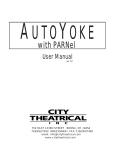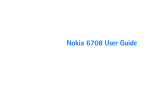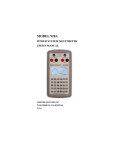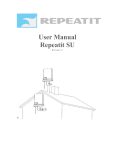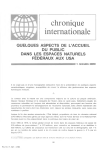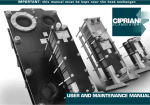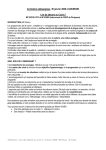Download si - Gas Gas
Transcript
TX RANDONNE 2014 GAS GAS thank you for the trust you have placed in us. Choosing the new GAS GAS TX RANDONNE 2014 you are joining the GAS GAS family and, as a user of brand number one for off-road bikes you deserve the distinguished treatment that we wish to offer you both in our after-sale relationship and in the explanations provided in this manual. Our TX RANDONNE 2014 is a bike to practice Trial-tour. It is a polyvalent model thought to make an amateur trial as well as excursion off road. Following the instructions in this user manual you will enjoy the trial practice as well as the trail tours quietly. Remember always ask for original spare parts to enlarge your bike’s life. Thanks for your confidence and be welcome to GAS GAS MOTOS. GAS GAS MOTOS, S.A. -1- Important notice Read this Manual carefully. You will find it contains all the necessary information for your safety, and that of third persons, as well as guaranteeing the correct conservation and maintenance of the GAS GAS motorbike you have just bought. You will find all the necessary instructions for the correct riding and control of this vehicle are set out below. Each message is proceeded by a sign whose meaning is the following: Be careful! This sign introduces all those rules and precautionary measures necessary to avoid slight or severe injuries, or even the death of the user should these instructions not be correctly followed. Look out! This sign introduces special warnings to avoid damaging your motorbike. Should these warnings not be heeded, the guarantee may be automatically invalidated. Various notes. These are the indications necessary for the optimal control and adjustment operations, together with those tasks of conservation and maintenance of the motorbike in order that you may obtain the greatest possible satisfaction from your vehicle. The aim of this Manual is to help the user to minimise or avoid possible damage to people, property, the environment, and naturally to his/her new motorbike. GAS GAS Motos, S.A. reserves the right to make modifications without any prior warning being given to consumers and without incurring any additional obligations in so doing. Your local dealer will also provide you with any information as might be deemed necessary. -2- Contents Thanks to consumer Important notice Warranty regulations Recommendations Technical specifications Electric scheme Component location Maintenance guide Serial number Combination switch Steering lock Fuel Fuel tank cap Fuel tap Starter Carburation Kick-start engine lever position Lever regulation Oil level checking Crankcase fill-in Crankcase draining Air filter box cleaning Spar plug 1 2 4 to 6 7 8 to 9 10 to 11 12 to 13 14 to 15 16 17 18 19 19 20 20 20 21 21 22 22 22 23 24 Front suspension Rear suspension Swing-arm link Articulation lubrication Chain fixing link position Chain and wheel tension Tyres and tyre pression Brakes Rear brake fluid tank Storage Multifunction Troubleshooting Finally recommendations -3- 25 26 27 28 to 30 31 31 32 33 34 35 36 to 38 39 to 42 43 WARRANTY TERMS AND CONDITIONS (According to Law decree 23/2003 on the 10th of July, covering Warranties on Consumer Item Sales) Warranty terms of the manufacturer GASGAS Motos, S.A. The company GAS GAS MOTOS, S.A. (hereafter referred to as “GG”), with this present document guarantees the consumer, the purchaser of a vehicle manufactured by GG, that both the materials and the manufacturing are free of defects in accordance with the highest standards of quality. Consequently, GG with this document guarantees the consumer (hereafter referred to as the “purchaser”), in accordance with the conditions set out below, the repair, free of charge, of any defect in materials or that might result from faulty manufacture that is detected in a new motorcycle within the period covered by this Warranty and with no limit on the number of kilometres covered or hours of use. Warranty Period The period covered by this Warranty will begin on the day of delivery of the vehicle to the purchaser by a GG authorised dealer, or in the case of demonstration models, on the date in which the vehicle is used for the first time. The seller will be responsible for any unwarranted faults that become apparent within the period established in the Law decree 23/2003 on the 10th of July covering Warranties on Consumer Goods Sold from the time of delivery and in accordance with the Directive 1999/44/EC for other members of the European Community. For countries outside the European Community, the Warranty Period will be determined by the existing regulations in those countries. Nevertheless, should the fault appear during the first six months after the delivery of the motorcycle, it will be presumed that the said fault existed at the time of delivery; from the end of the sixth month onwards, the purchaser must demonstrate that the unwarranted fault existed at the moment of delivery. During the first six months subsequent to the delivery of the repaired vehicle, the seller will be responsible for any unwarranted faults arising out of the repair. Any defects detected in the product must be brought to the attention of a GG authorised dealer within the Warranty Period. If the last day of this period is a Sunday or an official holiday, the Warranty period will be extended such that the last day of the period covered will be the first working day after the Sunday or official holiday. Those claims under Warranty for defects not brought to the attention of a GG authorised dealer before the end of the Warranty Period will be excluded. -4- Obligation of the purchaser GG will have the right to reject any claims under Warranty in the event that: a) The purchaser has failed to submit the vehicle to any of the inspections and/or maintenance work required in the Users’ Manual, or has exceeded the date set for such inspections or maintenance work. Also excluded from guarantee are those faults that appeared prior to the dates established for an inspection or maintenance work where the latter was not carried out, or was carried out later than the date established. b) An inspection, maintenance or repair has been performed on the vehicle by third parties not recognised or authorised by GG. c) Any maintenance or repair has been carried out on the vehicle that violates the technical requirements, specifications and/or instructions indicated by the manufacturer. d) Spare parts whose use has not been authorised by GG have been used during the course of maintenance work or repairs to the vehicle, or in the event that the vehicle has been used with fuels, lubricants or other liquids (including, amongst others, cleaning products) that have not been expressly mentioned in the specifications set out in the User’s Manual. e) The vehicle has been altered or modified in any way or fitted with components other than those expressly authorised by GG as accepted components of the vehicle. f) The vehicle has been stored or transported in a way that is not in accordance to the corresponding technical requirements. g) The vehicle has been used for special purposes other than ordinary use, such as competition, races or record breaking attempts. h) The vehicle has been directly or indirectly damaged as a result of a fall or an accident. Warranty exclusions The following items are not covered by this Warranty: a) Worn parts, including, without any limitation, spark plugs, batteries, petrol filters, oil filter elements, (secondary) chains, engine output pinions, rear sprockets, air filters, brake discs, brake pads, clutch plates and discs, bulbs, fuses, carbon brushes, footrest rubbers, tyres, inner tubes, cables and other rubber components b) Lubricants (for example, oil, grease, etc.) and working fluids (for example, battery liquid, coolant, etc.) c) Inspection, adjustments and other maintenance tasks, as well as all kinds of cleaning work d) Damage to the paint-work and consequent corrosion due to external causes, such as stones, salt, industrial fumes and other environmental impact, or inadequate cleaning with inappropriate products -5- e) Any damages caused as a result of the defects, as well as any expenses incurred either directly or indirectly as a consequence of the defects (for example, communication costs, accommodation expenses, car hire costs, public transport costs, breakdown truck fees,, courier costs, etc.), as well as other financial losses (for example, those caused by the loss of the use of the vehicle, loss of income, time lost, etc.) f) Any acoustic or aesthetic phenomenon that does not significantly affect the condition or use of the motorcycle (for example, small or hidden imperfections, noise or vibrations that are normal in use, etc.) g) Phenomena that are the result of the ageing of the vehicle (for example, discolouring of painted or metallic coated surfaces). Various 1.- GG shall have the prerogative to decide, at its own discretion, whether to repair or replace defective parts. Where parts are replaced, ownership of the parts removed shall pass to GG without any other consideration. The GG authorised dealer, to whom the making good of the defects has been entrusted, is not authorised to make any declarations that are binding on GG. 2.- In case of doubt regarding the existence of a defect, or a visual or material inspection is required, GG reserves the right to demand the return of the parts which are the object of a claim under Warranty, or to arrange an inspection of the defect by an expert from GG. Any additional obligations arising out of guarantees on parts replaced free of charge, or any other service rendered free of charge, are excluded from the effects of this present warranty. The Warranty on parts replaced within the Warranty Period will end at the expiry date for the Warranty Period of the product concerned. 3.- Should it prove to be the case that a defect can not be repaired, the purchaser guaranteed shall have the right to the cancellation of the contract (payment of compensation) or a partial refund of the purchase price (discount), instead of repairing the motorcycle. 4.- Any claims against Warranty by the purchaser under the terms of the sale contract with the corresponding authorised dealer shall not be affected by the terms of this present Warranty. Neither will this present Warranty affect those additional contractual rights acquired by the purchaser under the general commercial terms and conditions of the authorised dealer. However, such additional rights may only be exercised through claims against the authorised dealer. 5.- Should the purchaser resell the product within the Warranty Period, the duration and conditions of the present Warranty will remain unaltered, in such a way as that the rights to make claims under the present Warranty in accordance with the terms and conditions set out in this present document shall be transferred to the new owner of the motorcycle. -6- Recommendations for the reliable operartion of your GAS GAS. •Eight hours of running-in are recommended in order to guarantee the correct operation of the engine. •It is important to warm the engine to the optimum operation temperature every time the motorbike is used. -7- TECHNICAL SPECIFICATIONS MOTOR 4-stroke, single-cylinder, air-cooled 125cc. motor Capacity Diameter and stroke 123.3cc 54 x 54 Capacity Diameter and stroke 179’2 cc. 65x54 200 cc. motor Carburettor Lubrication system Ignition system PTK 34 Wet sump Electronic TRANSMISSION Transmission type Clutch type 5-speed Multi-disc system in oil bath Secondary transmission Gear ratio Chain st 1 – 37/14 (2,643) nd 2 – 32/18 (1,778) rd 3 – 25/19 (1,316) th 4 – 23/22 (1,045) th 5 – 21/24 (0,875) -8- 68/20 (3.400) 38/13 (2.111) Primary reduction ratio Overall drive ratio Transmission oil FRAME Type Tyres Suspension Suspension stroke Front fork oil Front fork oil level BRAKES Type Disc diameter DIMENSIONS Overall height Overall width Seat height Ground clearance Wheelbase Fuel tank capacity Capacity Type 1,2 L SF 15W/40 ø 40 mm Tubular profile made with Cr-Mo. 2,75 x 21” Trial 4,00 x 18” Trial tubeless. Adjustable tele-hydraulic fork ø 40 mm. Variable progressive system with mono-shock multiadjustable. 170 mm. 164 mm. FUCHS (RENOLIN MR 310) 160 mm. air chamber steel bar Front Rear Disc brake. ø185 mm. 4 piston calipers. ø150 mm. 2 piston calipers. Front Rear Front Rear Front Rear 1120 mm. 827 mm. 800 mm. 315 mm. 1330 mm. 4 litres. (Specifications subject to change wothout notice, which may not be applicable in every country). -9- TX RANDONNÉ 125cc ELECTRICAL DIAGRAM -10- TX RANDONNÉ 200cc ELECTRICAL DIAGRAM -11- 5 7 13 23 34 8 6 26 27 9 31 24 22 14 10 11 15 16 17 18 37 19 21 20 30 28 32 12 29 1 2 3 4 5 6 7 8 9 10 11 Front fender Front brake caliper Front suspension left leg Front suspension bar Breather hose Spark plug Filter box Rear fender Rear light Front tyre Front brake disc cover 12 13 14 15 16 17 18 19 20 21 22 Front brake disc Cylinder Carburetor Chain guide Chain tensioner Chain Rear sprocket cover Rear sprocket Rear rim Rear tyre Exhaust protection -12- 23 24 26 27 28 29 30 31 32 34 Frame Head pipe Headlight Front tyre air valve Rear brake disc Sidestand arm Swingarm Rear brake pedal Kickstart pedal Muffler 44 45 38 51 36 39 46 40 48 57 42 50 43 54 49 53 55 56 37 Excentric rear wheel 38 Left foot peg 39 Seat 40 Shift pedal 42 Fuel tank 43 Fuel tank cap 44 Left handlebar grip 45 Clutch lever 46 Light controls 48 Handlebar 49 Right foot peg 50 Multifunction 51 Indicators 53 Front brake pump -13- 54 Throttle cover 55 Front brake lever 56 Right handlebar grip The maintenance table and adjustments are easy to carry out and must be done to insure the motorcycle is in good running condition. MAINTENANCE TABLE Part Check / Inspect Adjust Replace / Change Clean Grease / Lubricate Rear shock absorber Transmission oil Front fork oil Brake adjust Swingarm and connecting rods Spark plug Throttle cable and twist grip Chain Carburetor Frame Carburetor jet Steering bearing Piston bearing Wheel bearing Engine bearing Rear sprocket Cylinder and cylinder head Brake Brake disc Clutch discs Clutch Engine protector plate Every year 30 hours Every race Every race Every race Every race Every race Every race Every race Every race 30 hours 60 hours Every race Every race Every race Every race If is necessary 30 hours If is necessary If is necessary If is necessary If is necessary First 5 hours If is necessary First 5 hours im a fall Every 2 years 60 hours 60 hours If is damaged 60 hours If is damaged If is damaged If is damaged If is damaged If is damaged If is damaged If is damaged If is damaged If is damaged If is damaged Every year If is damaged If is damaged If is damaged If is damaged if is damaged Every race 15 hours If is necessary Every race Every race Every race Every 2 races - Every cleaning Every cleaning Every cleaning . Every cleaning - -14- MAINTENANCE TABLE Part Check / Inspect Adjust Replace / Change Clean Grease / Lubricate Exhaust Packing Air filter Steering assembly Brake hose General lubrication Front and rear rims Tyres Brake oil level Chain guide slider Kickstart and shift pedal Brake piston pump anb the dustcover Brake piston and the dust-cover Piston and piston rings Front and rear spokes Fuel system Front suspension Bolts, nuts & fasteners Fuel hose Radiator hose set and connections Frame protect sickers Every race Every race Every race Every race Every race Every race Every race Every race Every race Every race 60 hours Every race Every race Every race Every race Every race - If is necessary If is necessary If is necessary 5 hours If is necessary If is necessary If is necessary 500 hours 100 hours If is damaged Every 2 years If is damaged If is damaged If is damaged If is damaged If is damaged If is damaged Every year If is damaged If is damaged If is damaged If is damaged If is damaged Every race Every race Every race Every race Every race - Every cleaning Every cleaning Every cleaning Every cleaning - -15- The new GAS GAS TX RANDONNE carries the appropriate certification plate whose details should coincide with those on the accompanying documentation and the frame number stamped on the steering arm. I Enter the vehicle identification number (serial number), the particulars shown on the model label, and the ignition-key identification number in the spaces provided, in order to simplify your future orders for spare parts or as a useful reference in the event of your vehicle being stolen. Serial number (A) This has been printed on the steering tube. It shows the frame number used for registering this machine. 8 SERIAL N. Homologation plate (B) The motorcycle carries a certification plate showing a serial number that has also been printed on the front, and this information must coincide with that contained in the vehicle documents. We recommend that this information be entered in the box below. Serial number. HOMOLOGATION P. Key identification numbers The motorcycle carries one key set. The identification number appears right on the key joints. This number may be quoted when ordering a spare to replace a lost key. (except some racing models) KEY NUMBER -16- The control panel includes lighting, turn signal, horn and engine stop switches. The indicator control has been located on the underside of the left-hand grip. To start the right-hand indicator, move this switch to the right; and likewise, to start the left-hand indicator, move this switch to the left. All light controls have been located on the left-hand grip; the various positions available are reached by sliding the main switch, which is on the left end of the grip. -17- Located under the suspension lower right side bracket. For correct operation, it is necessary to turn the handlebar completely towards the right until it stops, insert the key in the slot, turn it in counterclockwise direction, press and to turn it again in clockwise direction. The key can now be removed and the steering will remain locked. C C Fuel tank capacity : 4 liters Use premium gasoline with an octane rating equal to or higher than that shown in the table. OCTANE RATING METHOD MINIMUM RATING Antiknock Index (RON + MON)/2 90 Research Octane No. (RON) 98 I Never leave the key in the lock. If the steering is turned with the key in the lock it may be damaged and the locking system could be damaged. 8 Gasoline is extremely flammable and can be explosive under certain conditions. Always stop the engine and do not smoke. Make sure the area is well ventilated and free from any source of flame or sparks; this includes any appliance with a pilot light. -18- The fuel tank cap is of the quick release type. To open the cap, lift the tab and turn it 1/4 turn in counterclockwise direction. To close it, place cap with the words GAS GAS in the upper position, and turn the tab in clockwise direction. It is important to check periodically the condition of the cap sealing O’ring to insure proper sealing. -19- A B 8 7 C The position of the fuel tap (A) must be pointing down for normal operation. When turned forwards, it opens the reserve, to the rear turns off the fuel. C Reserve Open -20- Closed The regulation idling engine can be adjusted by the screw B and the air regulation by the C screw. Like the c l u t c h lever, the front brake lever must be in the ideal position. Again, the play must not exceed 3mm. C mínimum 3mm.mínimum 7 The clutch lever must be adjusted to your liking, but the free play should not exceed 3mm. This play must never be eliminated. C This play must never be eliminated. C 8 The choke (B) is a device for aiding the starting when cold. The enigne will reach a normal temperature in a short time and it won’t damage anything. -21- I This is the position the kick-start should be in when not being used. C Refill oil removing the cap (A). 8 Oil capacity: 1,2L (15W/40) C The cap to make the engine empty of oil is located at the botton left of engine. 8 8 C To check the oil level, fix the bike perpendicular to floor. If the engine was running wait few minutes. Check the level with the rod joined to the oil cap: remove oil cap, clean the rod, introduce and get out the rod, now you can see the oil level. This level must be between max and min. If it is too high, drain the excess. If it is too low, add the necessary quantity by opening the oil cap. Use the same type and make of lubricant as that which is already in the engine. -22- D A Is important to check periodically the air-filter. E Get the saddle out removing the screw (A). Remove the screws (B) and take the cover out. Access to the airfilter (C). Remove screws (D) and pull the air-filter up. Remove screw (E) and filter foam is free. Use watter and detergent for cleaning, dry it carefully an oil it with proper oil for air filter. -23- B C 7 C It is necesassary to periodically check the spark plug condition. This must be done removing the spark plug from the upper part of the cylinder head. First disconnect the spark plug cap and remove area first. Clean the spark plug with compressed air to remove dirt and prevent foreign material from entering inside the engine compartment. 7 I The sparking plug distance should be between 0.6 and 0.7mm. SPARK PLUG TYPE: A6 RTC ~ 0,7 mm. 0,6 _ -24- Level of air chamber 160 mm. FRONT FORK ø 40 mm 760 mm -25- REAR SUSPENSION C The preloading of the damper spring is measured by the rotation of the toothed rings (C) with the aid of a special wrench. 7 Free spring high: 140mm Spring high preloaded (Lp): 134mm Standard spring preload (P): 6mm -26- The linkage at the lower part of rear suspension must be periodically cleaned, inspected and lubricated with grease. Ii is very important to periodically remove and verify the condition of the swingarm bearings and pieces. -27- C Use special oil to lubricate the following: 8 C 3) Also the rear brake pedal (bearings). C 4) Apply grease to the footrest springs and fixtures. 8 8 -28- C 8 1) All pivot points of the brake and clutch levers. 2) The pivot of the gear shift lever. 8 C 8 6) The drive chain must be cleaned and lubricated thouroughly and frequently since it is exposed to the elements and constant abrassion. C 5) Apply grease to the linkage of the engine starting pedal. -29- 7 7 C 7) It is also recommended to frequently lubricate the chain tensioner spring because it is under great stress. C -30- 8) Oil and clean the throttle control frequently; it is especially recommended to do so after the bike has been cleaned with water under high pressure. 7 7 C C To regulate the chain slack and center the rear wheel use the shaft excentrics which can be easily adjusted. The chain master link clip must be placed in opposite direction of the wheel travel. -31- 7 C All tyre conditions must checked to insure optimum. Fig. 1 - Bad condition Fig. 2 - Good condition 7 C Front tyre: 2,75 x 21” TRIAL Rear tyre: 4,00 x 18” TRIAL (tubeless) Tyre pressure should be checked periodically to insure the best. Front wheel pressure: 1,5bar bar--normal normal 1,5 0,5 0,5 bar bar - trial Rear wheel pressure: 1,5 1,5bar bar--normal normal 0,5 0,5 bar bar - trial -32- Brake pad wear, front and rear, must be checked from time to time to insure an efficient braking power under all circumstances. C 8 7 7 C The front brake fluid level can be verified through the transparent inspection window. 7 -33- C The brake calipers have been furnished with bleeder valves to eliminate the air trapped in the brake system. 7 C Verify fluid level periodically and refill if necessary. To check the break liquid level, fix the bike perpendicular to floor, the level must be between MAX and MIN marks. To be correct the level and marks in the tank must be parallel. C MAX MIN -34- STORAGE For extended storage of the motorcycle, you must do the following: - Clean the motorcycle thoroughly. - Start the engine for about 5 minutes to warm up the transmission oil and then drain it (see “crankcase drain cap” ) - Fill with new transmission oil. - Empty the fuel tank (gasoline will deteriorate if left too long). - Lubricate the chain and all cables. - Cover all unpainted metal surfaces with a coat of oil to prevent rust, do not apply oil to the brakes and rubber parts. - Cover the exhaust pipe with a plastic bag to prevent corrosion. - Place the motorcycle in such a position so that the wheels do not touch the ground (if possible, place cardboard under the wheels). - Cover the motorcycle to protect it from dust and dirt. When starting off after an extended storage: - Remove the plastic bag from the exhaust pipe. - Tighten the spark plug. - Fill the fuel tank. - General lubrication. - Inspect tyre pressure and inflate to the specified pressure, if necessary. I To avoid excessive ageing of the plastic parts and other washable pieces of the motorcycle, it is suggested that these items must be washed carefully. If the washer applies water at high pressure and/or temperature, take the precaution of maintaining the washer outlet gun at a distance of 30 centimeters minimum, this will insure the correct gloss of the plastics and adherence of the selfadhesive labels that decorate the motorcycle. -35- Multifunction gauge (Only on certain models and markets) QUICK GUIDE: SETUP MENU The multifunction device is water resistant, has 3 buttons with a brightly lit LCD. To enter into the setup menu endurance II, hold buttons 1, 2 and 3 for three seconds. Be sure to hold the 3 buttons at the same time. • Current speed • Backlight Full time • Average speed • Maximum speed • Two independent tripmeters • Odometer (total kms) • Time on motorcycle • Chronometer • Tracking total hours • Clock • Maintenance Reminder • Travel Distance WARNING The multifunction device is water resistant but not waterproof. Do not wash with pressure washer. Do not leave the device in direct sunlight when the motorcycle is stopped. Avoid contact with gasoline, degreasers or other cleaning chemical products that could be cause damages in the device. Always remeber tot pay attention to the road when you’re driving. -36- BUTTONS SUMMARY: Button 1: Increase (above) Button 2: Decrease (below) Button 3: Next configuration ADJUSTING the distance units: Select the units (kilometers or miles) with 1 or 2 buttons. SET the front tire size: Select the size with button 1 or 2 (2300m). ADJUST the clock format: Select the desired format using the buttons 1 or 2 (12H or 24H). SETTING the time: Set the clock to the desired time by pressing 1 to 2. SETTING the maintenance reminder method: Select the desired maintenance reminder method using the buttons 1 or 2. ODO: Odometer. kilometers based. ART: Accumulated driving time, hours based. SETTING the maintenance reminder: Select the value until the next maintenance. This value is based on time or mileage, depending on the method chosen on the previous menu (ODO/ART). -37- SCREENS IN NORMAL MODE: Screen 1: DST DST (Distance Traveled). DST function accumulates the distance data since the last reset while you’re riding a motorcycle. Press and hold buttons 1 and 2 for three seconds to reset DST (Distance 1 ). Hold the button 3 to set the DST. Use buttons 1 and 2 to increase and decrease the DST. Press the 3 button to return to main menu. Screeb 2: DST2 DST2 (Distance Traveled 2). The multifunction ENDURANCE II, can accumulate data from two different travel distances. Press and hold buttons 1 and 2 for three seconds to reset DST2, driving time and average speed. Hold the button 3 to set the DST. Use buttons 1 and 2 to increase and decrease the DST. Press the 3 button to return to main menu. -38- TROUBLESHOOTING NOTE This is not an exhaustive list of malfunctions, it only shows the most common problems. POSSIBLE CAUSE REMEDY - Seized crankshaft. - Seized cylinder / piston / jornal bearing. - Seized transmission assembly. - Motorcycle inactive too long. - Go to a specialized workshop. - Go to a specialized workshop. - Go to a specialized workshop. Drain old fuel out of the tank. With the fuel tank filled with new fuel, the engine will start immediately. - Clean and dry or replace the spark plug. - In order to "relieve the engine", accelerate to max. speed, press the starter pedal 5 or 10 times. Then, start the engine as described above. If the engine fails to start, remove the spark plug and dry it. - Clean the fuel tank air vent. Adjust the air cleaner duct. MALFUNCTION 1 Engine does not start - Wet or fouled spark plug. - Flooded engine. - Incorrect air/fuel mixture. 2 Engine start but then stops - Incorrect air supply. - Close the starter. Clean fuel tank air vent. Adjust the air cleaner duct. - Fill up the fuel tank. - No fuel. -44- MALFUNCTION POSSIBLE CAUSE REMEDY 3 The engine operates irregularly - Ignition rotor damaged. - Water in fuel. - Replace the rotor. - Drain the fuel tank and fill up with new fuel. 4 Engine lacks power or poor acceleration - Fuel supply defective. - Dirty air cleaner. - Leaking or deteriorated exhaust system. - Dirty carburetor jets. - Worn or damaged crankshaft bearings. - Clutch slips. - Clean the fuel system and verify its operation. - Clean or replace the air cleaner. Verify its operation. - Verify if the exhaust system is damaged. Replace the muffler fiberglass packing, if necessary. - Disassembly the carburetor and clean all jets. - Replace the crankshaft bearings. - Verify the clutch operation. Go to a specialized workshop. 5 Abnormal engine noise - Ignition problem. - Overheating. - Go to a specialized workshop. - Refer to section 5. 6 Detonations from the exhaust pipe - Carbon build up in combustion chamber. - Incorrect octane or poor quality gasoline. - Damaged spark plug or incorrect specifications. - Deteriorated exhaust system gaskets. - Clean the combustion chamber. - Drain all gasoline and fill up with a higher octane fuel. - Replace the spark plug with a new one of the correct type. - Verify if the exhaust system is damaged. All gaskets must be in perfect conditions, otherwise replace them with new ones if necessary. 7 White smoke coming out of the exhaust pipe - Deteriorated cylinder head gasket (water leakage into the cylinder). - Incorrect throttle cable adjustment. - Replace the cylinder head gasket. Go to a specialized workshop. - Readjust the throttle valve cable. 8 Brown smoke coming out of the exhaust pipe - Restricted air cleaner. - Clean or replace the air cleaner. Go to a specialized workshop. - Verify main jet operation. Go to a specialized workshop. - Main jet set too high. -40- MALFUNCTION POSSIBLE CAUSE REMEDY 9 The motorcycle is unstable - Cable interferes with the handlebar. - Steering stem locknut too tight. - Damaged or worn steering bearings. - Bent steering stem. - Move or loosen the cable just a little. - Loosen the steering stem locknut. - Replace the steering bearings. - Replace the steering stem. Go to a specialized workshop. 10 Shock absorber set too hard - Excessive front fork oil. - Front fork oil viscosity too high. - Bent front fork. - Pour excess oil until reaching the correct oil level. - Drain fork oil and fill with correct fork oil viscosity. - Replace the front fork. Go to a specialized workshop. - Tire air pressure set too high. - Incorrect rear shock absorber adjustment. - Check tire air pressure. - Adjust rear shock absorber. - Insufficient front fork oil. - Front fork oil viscosity too low. - Fill with fork oil until reaching the correct oil level. - Drain fork oil and fill with correct fork oil viscosity. - Bent front fork. - Replace the front fork. Go to a specialized workshop. - Incorrect rear shock absorber adjustment. - Adjust the rear shock absorber. - Incorrect drive chain adjustment . - Worn drive chain. - Adjust the drive chain. - Replace the drive chain, rear sprocket and the secondary transmission pinion. - Replace the rear sprocket. - Lubricate with appropriate chain oil. - Align the rear wheel. Go to a specialized workshop. - Add front fork oil until reaching the correct level. - Replace the front fork spring. - Change the disc brake. - Reinstall or replace pad. - Replace the damaged cylinder. - Verify and adjust to the correct torque values. 11 12 Shock absorber set too soft Abnormal motorcycle noises - Worn rear sprocket teeth. - Insufficient drive chain lubrication . - Incorrect rear wheel alignment. - Insufficient front fork oil. - Weak or broken front fork spring. - Worn disc brake. - Pad installed incorrectly or surface glazed. - Damaged cylinder. - Improperly tightened brackets, nuts, bolts. -41- MALFUNCTION 13 14 Abnormal motorcycle noises Handlebar vibration POSSIBLE CAUSE - Damaged cylinder. - Replace the damaged cylinder. - Brackets, nts, screws not tighted. - Check and adjust to the correct tightening torques. - Excessive steering axles tolerances. - Tighten steering bracket and steering stem locknut to the correct torque values. - Tighten steering bracket and steering stem locknut to the correct torque values. - Loose handlebar bracket, and loos handlebar stem locknut. 15 Motorcycle pull to one side 16 Brakes do not operate correctly REMEDY - Bent chassis. - Incorrect steering adjustment. - Bent steering stem. - Bent front fork. - Incorrect wheel alignment. - Replace the chassis. Go to a specialized workshop. - Adjust the steering. Go to a specialized workshop. - Replace the steering stem. Go to a specialized workshop. - Replace the front fork. - Align the wheels. - Worn discs. - Leaking brake fluid. - Replace the discs. - Verify the brake circuits. Replace the damaged or broken parts. - Drain the brake fluid and fill with the new fluid recommended by the manufacturer. - Replace the pump piston. - Adjust brakes. - Deteriorated brake fluid. - Broken pump piston. - Incorrect brake adjustment. -42- FINAL RECOMMENDATIONS PREVENTIVE ADVICE Before you ride the vehicle, take all the time you may require to check your motorcycle, carry out the periodical upkeep and check all functions. In different sections of this manual you will find data and work specifications that must be done at an autorized GAS GAS dealer, because of this and to extend the useful life of the motorcycle, all periodical inspections must be carried out by specially trained professionals at a GAS GAS Post-Sale Service Shop. Poor maintenance work of the motorcycle or not taking proper care of any problem, even if its concern, can cause severe personal injury and may lead to death. I is a small To avoid excessive ageing of the plastic parts and other washable pieces of the motorcycle, it is suggested that these items must be washed carefully. If the washer applies water at high pressure and/or temperature, take the precaution of maintaining the washer outlet gun at a distance of 30 centimeters minimum, this will insure the correct gloss of the plastics and adherence of the self-adhesive labels that decorate the motorcycle. SAFE RIDING OF THIS MOTORCYCLE Safe riding of a motorcycle does not only depend on the vehicle. The driver’s intelligence and common sense are key factors to be taken into consideration. It is recommended that you practice your favorite sport wearing all the necessary safety equipment (helmet, protection gear, boots, etc.). LEGAL ADVICE In the interest of technical development we reserve the right to modify the construction, the equipment and accessories of the motorcycle. It is understood that all measurements, weights and power data must include their respective tolerances. The photographs included in this manual may not match the model you have purchased. The descriptions and the illustrations may vary depending on the volume of equipment and accessories of your motorcycle and also of the versions exported. Because of this, there can be no liability in case of errors, misprint or omission. GAS GAS MOTOS, S.A. reserves the right to make changes and/or modifications at any time without notice. -43-













































